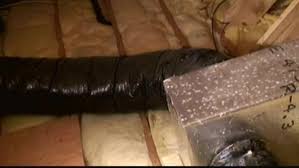Properly Insulating Heating and Air Conditioning Ductwork Can Save You a Lot of Money on Monthly Home Energy Bills
By Mark J. Donovan
|
|
In this video Mark Donovan of HomeadditionPlus.com explains why it is important to properly insulate HVAC ductwork in an attic.
Often attics are properly insulated and ventilated but the attic heating and air conditioning ductwork is not. This is a huge mistake. I will first explain why proper attic insulation and ventilation are crucial in a home.
By having sufficient attic insulation there is little heat loss from the lower level living areas of the home. In addition, with a cold attic there is reduced risk of ice dams building up along the home’s roof eaves.
Similarly, during the hot summer months, when the outside air temperature is ninety five degrees Fahrenheit the attic should be roughly the same. Again, by having sufficient attic insulation there is little air conditioning escaping from the lower level living areas of the home. Also, by having sufficient attic ventilation, heat build up in the attic is prevented. Heat build up can cause roof shingles to have a shorter life span and make the upper living areas of your home feel extremely warm.
| Need for Proper Insulation of Attic HVAC Ductwork
Often HVAC contractors install heat exchanger heating systems in attics. The heat exchanger converts hot water and cold refrigerant into hot and cold air respectively. The hot and cold air is then piped through a series of attic ductwork into the home’s living areas. The problem arises when the HVAC contractor, or general contractor, do not properly insulate around the HVAC ductwork. |
 |
Typical HVAC ductwork has an insulating R-value of only around R-4.3. For most parts of the country the Department of Energy suggests attic insulation have an R-value between R-38 to R-49.
In most cases a general contractor building a home will follow the Department of Energy’s guidelines for attic insulation and put copious amounts of insulation in-between the ceiling joists.
Unfortunately, too often the heating and cooling ductwork is simply laid on top of the attic insulation. As a result, with its poor insulating R-Values it is exposed to effectively the outside ambient air temperatures. So what does all this mean?
In the winter, for example, when it’s say ten degrees Fahrenheit outside, and in the attic your heating system is trying to pump hot air from the heat exchanger through all of the attic ductwork it becomes a major problem. Since the poorly insulated ductwork is likewise sitting at a ten degrees Fahrenheit temperature it is effectively transferring the heat into the attic as the hot air travels down the ductwork. So by the time the “hot air” finally comes out of the heat registers in the living space, instead of pumping out hot air it’s pumping out lukewarm air at best. Often the “hot” air coming out of the heating registers actually feels cool. So instead of heating your living space, it is actually cooling it.
The same situation exists during the summer months. Cool air from the air conditioning heat exchanger is being warmed as it travels the length of the poorly insulated ductwork. By the time it makes it out of the registers the air is no longer cool. As a result, your air conditioning system is pumping out into the living spaces of your home not very cool air. If the attic is not properly insulated the air conditioning system may actually be heating the living spaces of the home.
So check you attic heating and cooling ductwork. If it is lying on top of the attic insulation you have a problem. Consider spraying foam insulation all around the ductwork to increase the R-Value to at least an R-12 level. If spraying foam insulation is too expensive of a solution then attach rigid foam insulation around the HVAC plenum and place strips of R-18 insulation over the lengths of ductwork.
By properly insulating your HVAC ductwork your furnace and air conditioning systems won’t have to work as hard and as long to heat and cool your home. And as a result, you’ll save on monthly home heating and cooling energy bills.
For information on how to maximize a wood stove’s heating efficiency, see HomeAdditionPlus.com’s Installation of Hood over Wood Stove eBook.
Related Information
- How to Save on Home Energy Costs Video
- Install Fresh Air Intack on Oil Burner Video
- Condensation on HVAC Flex Tubing Ductwork in Attic
- Change Ceiling Fan Switch and Save on Home Heating Costs
Additional Heating and Cooling Resources from Amazon.com
 |
 |
Free Heating and Cooling Price Quotes with No Obligation!
Fill out our 3-5 minute quick and easy form, and receive a free price quote on heating & cooling from one of our pre-screened and licensed HVAC contractors. This process is free and there is no obligation to continue once you receive your heating & cooling price estimate.

